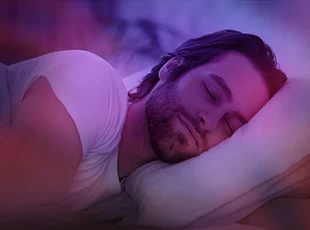

It’s almost Daylight Saving Time, when we move the clock forward by one hour and look ahead to long, bright summer days. The not-so-fun fact: Daylight Saving Time can affect your sleep hygiene, which can in turn affect your health. Keep reading to find out why Daylight Saving Time affects your sleep, and 3 tips on how to adjust, so you can stay on track even when the clocks spring forward.
What is daylight savings?
Daylight Saving Time (DST) falls between the second Sunday of March and the first Sunday in November. During this time, we move clocks forward one hour, so we can experience more natural daylight during the summer months. The time between fall and spring is simply called standard time.1Why daylight savings may disrupt your sleep
Moving the clock forward adjusts when and how long we experience natural daylight throughout the day. The day the clock springs forward, your body will likely naturally wake up an hour later, and that evening, your bedtime will come an hour earlier. The days following, your body will need to adjust to the “loss” of an hour, without adjusting your daily schedule. A German study published by Anne-Marie Schneider noted, “Class and performance tests should not take place in the first week after the transition into DST.”4Beyond that first week, our bodies also must adjust to waking up in the darkness, and spending part of the evening in the daylight. This may affect your circadian rhythm.2 According to the American Academy of Sleep Medicine, “Daylight saving time is less aligned with human circadian biology.”5 The sleep-wake cycle responds to light predictably. DST increases morning darkness and evening light, but our work and school schedules don’t adjust to the light exposure. In short, you may feel more tired or groggy in the mornings during DST, and more alert in the evenings.6Want to spring forward without missing out on sleep? Read on for our tips to help you get a full night’s sleep when the clocks move forward for daylight savings.
- Gradually change your sleep schedule—and your kids’!
- Consider a melatonin supplement
- Avoid scheduling anything important the morning after the time change
1. Gradually change your sleep schedule—and your kids’!
Purposefully shift your and your kids’ sleep schedule in the few days leading up to the time change. Starting Thursday or Friday before the second Sunday in March, adjust your bedtime and alarm clock by 15 to 20 minutes each night.4 That way, by the time the clock springs forward on Sunday, your body is already adjusted to the time change.2. Consider a melatonin supplement
More time in the daylight feels great—until you’re tossing and turning in the middle of the night. Consider taking a melatonin supplement as a short-term sleep aid to help regulate your sleep cycle.
3. Avoid scheduling anything important the morning after the time change
The best tip for better sleep during daylight savings: Don’t schedule anything for the Sunday after the clock moves forward an hour. There’s a good chance you’ll be late for any appointments you have scheduled for you or your kids that day, or the hosts will still be sleeping or groggy if you arrive on time. Let yourself get a full night’s sleep and map out how you’ll get back to your regular sleep routine instead. If you didn’t change your clocks the night before, you’ll probably wake up confused when smart clocks automatically move the time, and manual ones don’t. Plus, kids who tend to be night owls may experience daytime sleepiness.3
The moral of the story: Stay on track with your sleep routine as best you can when the time changes. Whether it’s Daylight Saving Time or Standard Time, the same best practices that help you get a good night’s sleep still apply. That includes setting and sticking to a sleep and wake schedule, putting away phones and bright screens 30 minutes before bed, avoiding caffeine in the evenings, etc.
*This statement has not been evaluated by the Food and Drug Administration. This product is not intended to diagnose, treat, cure, or prevent any disease.References:
- “Daylight Saving Time 2021: When Does the Time Change?,” The Old Farmer’s Almanac
- Zhang H, Dahle´n T, Khan A, Edgren G, Rzhetsky A (2020) Measurable health effects associated with the daylight saving time shift. PLoS Comput Biol 16(6): e1007927. https://journals.plos.org/ploscompbiol/article?id=10.1371/journal.pcbi.1007927
- Schneider AM, Randler C. Daytime sleepiness during transition into daylight saving time in adolescents: Are owls higher at risk?. Sleep Med. 2009;10(9):1047-1050. doi:10.1016/j.sleep.2008.08.009
- "5 Tips to Help Your Body Adjust to the Time Change,” The Old Farmer’s Almanac
- & 6. “Daylight Saving Time,” Sleep Foundation




